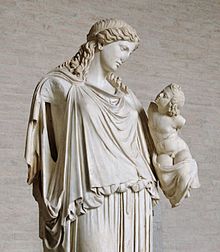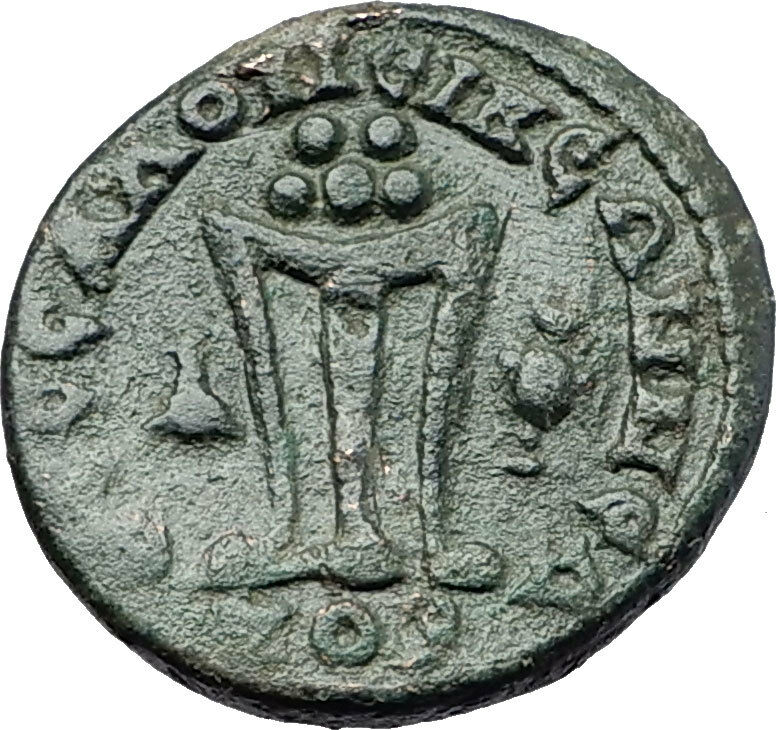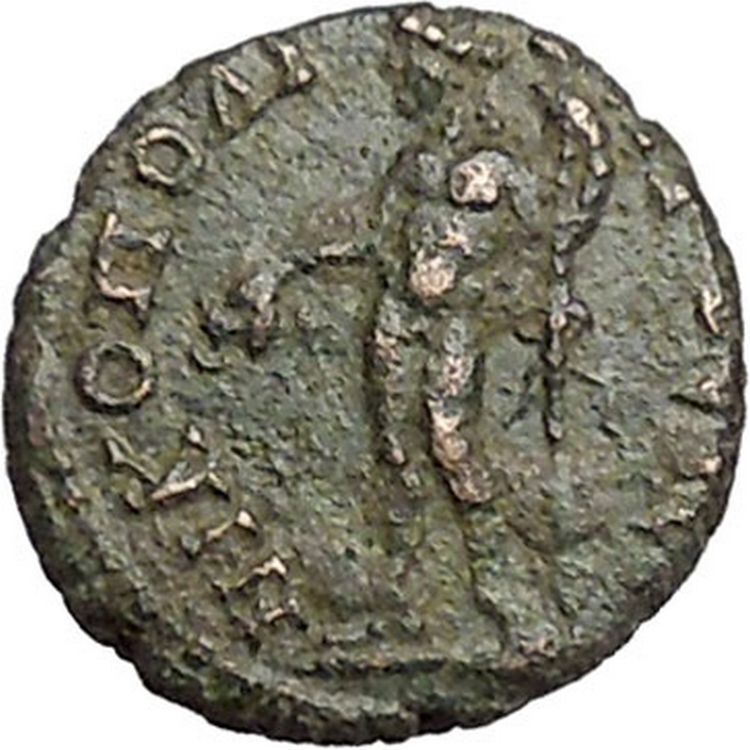|
Galba – Roman Emperor: June 10th 68 A.D. – January 15th 69 A.D.
Billon Silver Tetradrachm 26mm (13.01 grams) of Alexandria in Egypt
Dated Regnal Year (RY) 1, Struck June – August 28, 68 A.D.
Reference: Köln 219; Dattari 302; Milne 309; Emmett 171; RPC I 5328
Certification: NGC Ancients Ch VF Strike: 4/5 Surface: 4/5 5872968-001
ΛOYK ΛIB ΣOYΛΠ ΓΑΛΒΑ ΚΑΙΣ ΣΕΒ AYT, Laureate head of Galba right; L A (date) below chin.
EIPHNH, Veiled and draped bust of Eirene right, caduceus over shoulder.
You are bidding on the exact item pictured, provided with a Certificate of Authenticity and Lifetime Guarantee of Authenticity.
Billon is an alloy of a precious metal (most commonly silver) with a majority base metal content (such as copper). It is used chiefly for making coins, medals, and token coins. The word comes from the French bille. The use of billon coins dates from ancient Greece through the Middle Ages. During the 6th and 5th centuries BC, some cities on Lesbos Island used coins made of 60% copper and 40% silver. Billon coins are perhaps best known from the Roman Empire, where progressive debasements of the Roman denarius and the Roman provincial tetradrachm.
 Eirene, more commonly known in English as Peace, was one of the Horae, the personification of peace. She was depicted in art as a beautiful young woman carrying a cornucopia, sceptre, and a torch or rhyton. She is said sometimes to be the daughter of Zeus and Themis. Her Roman equivalent was Pax. Eirene, more commonly known in English as Peace, was one of the Horae, the personification of peace. She was depicted in art as a beautiful young woman carrying a cornucopia, sceptre, and a torch or rhyton. She is said sometimes to be the daughter of Zeus and Themis. Her Roman equivalent was Pax.
She was particularly well regarded by the citizens of Athens. After a naval victory over Sparta in 375 BC, the Athenians established a cult for Peace, erecting altars to her. They held an annual state sacrifice to her after 371 BC to commemorate the Common Peace of that year and set up a votive statue in her honour in the Agora of Athens. The statue was executed in bronze by Cephisodotus the Elder, likely the father or uncle of the famous sculptor Praxiteles. It was acclaimed by the Athenians, who depicted it on vases and coins.
Although the statue is now lost, it was copied in marble by the Romans; one of the best surviving copies (right) is in the Munich Glyptothek. It depicts the goddess carrying a child with her left arm – Plutus, the god of plenty and son of Demeter, the goddess of agriculture. Peace’s missing right hand once held a sceptre. She is shown gazing maternally at Plutus, who is looking back at her trustingly. The statue is an allegory for Plenty (i.e., Plutus) prospering under the protection of Peace; it constituted a public appeal to good sense. The copy in the Glyptothek was originally in the collection of the Villa Albani in Rome but was looted and taken to France by Napoleon I. Following Napoleon’s fall, the statue was bought by Ludwig I of Bavaria.
 Galba (Latin: Servius Sulpicius Galba Caesar Augustus; 24 December 3 BC – 15 January 69), pron.was Roman Emperor for seven months from 68 to 69. Galba was the governor of Hispania Tarraconensis, and made a bid for the throne during the rebellion of Julius Vindex. He was the first emperor of the Year of the Four Emperors and the last emperor born in the First Century BC. Galba (Latin: Servius Sulpicius Galba Caesar Augustus; 24 December 3 BC – 15 January 69), pron.was Roman Emperor for seven months from 68 to 69. Galba was the governor of Hispania Tarraconensis, and made a bid for the throne during the rebellion of Julius Vindex. He was the first emperor of the Year of the Four Emperors and the last emperor born in the First Century BC.
Origins and family life
He was born as Servius Sulpicius Galba near Terracina, “on the left as you go towards Fundi” in the words of Suetonius.
Through his paternal grandfather (“more eminent for his learning than for his rank – for he did not advance beyond the grade of praetor” and who “published a voluminous and painstaking history”, and, according to Suetonius, predicted his rise to power), he was descended from Servius Sulpicius Galba. Galba’s father attained the consulship, and although he was short, hunchbacked and only an indifferent speaker, was an industrious pleader at the bar.
His mother was Mummia Achaica, the granddaughter of Lutatius Catulus (cos. 78) and great-granddaughter of Lucius Mummius Achaicus. They only had one other child, an elder son called Gaius who left Rome after squandering the greater part of his estate, and committed suicide because Tiberius dishonored him by preventing him from taking part in the allotment of the provinces in his year. His father married a second wife, Livia Ocellina, a distant kinswoman of the empress Livia. She later adopted Galba, so he took her names, remaining Lucius Livius Ocella Sulpicius Galba until becoming emperor.
His was a noble family, and he was a man of great wealth, but was unconnected by birth and only very, very remotely by adoption with any of the first six Caesars. In his early years he was regarded as a youth of remarkable abilities, and it is said that both Augustus and Tiberius prophesied his future eminence (Tacitus, Annals, vi. 20; Suet. Galba 4; Dio 57.19.4).
His wife, Aemilia Lepida, however, was connected by the marriages of some of her relatives to some of the Julii-Claudii. They had two sons, probably Gaius and Servius (most likely Livius Ocella Galba), who died during their father’s life. The elder son was born circa 25 AD. Hardly anything is known about his life as he died young. He was engaged to his step-sister Antonia Postuma, but they never wed, which leads modern historians to believe that he died during this time. Their engagement is dated to 48, and that is generally believed to be his time of death.
The date of birth of the younger son occurred later than 25 but before 30. This Galba outlived his older brother. He was a quaestor in 58, but he was never seen in politics after that. His time of death is generally believed to be around 60 AD. Galba Minor was never married and had no children.
In addition, Suetonius’s description of Galba was that “In sexual matters he was more inclined to males, and then none but the hard bodied and those past their prime”. This seems to be the only case in Roman history where a named individual male is stated to prefer adult males.
Public service
He became Praetor in 20, and consul in 33; he earned a reputation in the provinces of Gaul, Germania, Africa and Hispania for his military capability, strictness and impartiality. On the death of Caligula, he refused the invitation of his friends to make a bid for the empire, and loyally served Claudius. For the first half of Nero’s reign he lived in retirement, until 61, when the emperor bestowed on him the province of Hispania Tarraconensis.
In the spring of 68, Galba was informed of Nero’s intention to put him to death, and of the insurrection of Julius Vindex in Gaul. He was at first inclined to follow the example of Vindex, but the defeat at Vesontio (Besançon) and suicide of the latter renewed Galba’s hesitation. It was said that the courtier Calvia Crispinilla was behind his defection from Nero.
The news that Nymphidius Sabinus, the Praetorian Prefect, had given him his favour revived Galba’s spirits. Until now, he had only dared to call himself the legate of the senate and Roman people; after Nero’s suicide, he assumed the title of Caesar, and marched straight for Rome.
Following Nero’s death, Nymphidius Sabinus sought to seize power prior to the arrival of Galba, but he could not win the loyalty of the Praetorian guard and was killed. Upon Galba’s approach to the city in October, he was met by soldiers presenting demands; Galba replied by killing many of them.
Emperor (June 68)
Rule
Galba’s primary concern during his brief reign was restoring state finances, and to this end he undertook a number of unpopular measures, the most dangerous was his refusal to pay the praetorians the reward promised in his name. Galba scorned the notion that soldiers should be “bribed” for their loyalty. He was notoriously cruel throughout the Empire; according to the historian Suetonius, Galba levied massive taxes against areas that were slow to receive him as Emperor.
He also sentenced many to death without trial, and rarely accepted requests for citizenship. He further disgusted the populace by his meanness and dislike of pomp and display. Advanced age destroyed his energy, and he was entirely in the hands of favourites.
Three of these – Titus Vinius, who became Galba’s colleague as consul, Cornelius Laco, the commander of the Praetorian Guard, and Galba’s freedman Icelus Marcianus – were said to virtually control the emperor. The three were called “The Three Pedagogues” because of their influence on Galba. All this made the new emperor gravely unpopular.
During the later period of his provincial administration, Galba was indolent and apathetic, but this was due either to a desire not to attract Nero’s notice or to the growing infirmities of age. Tacitus says all pronounced him worthy of the empire, until he became emperor (“omnium consensū cāpax imperiī nisi imperasset“).
Military mutiny on the frontier
On 1 January 69, two legions in Germania Superior refused to swear loyalty to Galba. They toppled his statues, demanding that a new emperor be chosen. On the following day, the soldiers of Germania Inferior also rebelled and took the decision of who should be the next emperor into their own hands, proclaiming the governor of the province, Vitellius, as Emperor.
This outbreak of revolt made Galba aware of his own unpopularity and of the general discontent. In order to check the rising storm, he adopted as his heir and successor L. Calpurnius Piso. The populace regarded the choice of successor as a sign of fear and the Praetorians were indignant, because the usual donative was not forthcoming. Furthermore, M. Salvius Otho, who was expecting to be adopted, was alienated by the choice of Piso.
Assassination (January 69)
While Otho had governed Lusitania and was one of Galba’s earliest supporters, he was disappointed at the selection of Piso and entered into communication with the discontented Praetorians, who hailed him as their emperor on 15 January 69. Galba at once set out to meet the rebels, though he was so feeble that he had to be carried in a litter. According to Suetonius, Galba prior to his death had put on a linen corset-although remarking that it had little protection against so many swords. He was met by a troop of Otho’s cavalry and was killed near Lacus Curtius. One guard, centurion Sempronius Densus, died defending him. Piso was killed shortly afterwards. According to Plutarch, during Galba’s last moments he offered his neck, and said, “Strike, if it be for the good of the Romans!”
After his death, Galba’s head was brought to Otho, who gave it to his camp followers who paraded and mocked it-the camp followers’ mocking was their angry response to a remark by Galba that his strength was unimpaired. The head was then bought by a freedman so he could throw it on the place where his former master had been executed on Galba’s orders. Galba’s steward buried both head and trunk in a tomb by the Aurelian Road.
See also
- Sulpicia (gens)
- Galba (Suessiones)
|









 Eirene, more commonly known in English as Peace, was one of the Horae, the personification of peace. She was depicted in art as a beautiful young woman carrying a cornucopia, sceptre, and a torch or rhyton. She is said sometimes to be the daughter of Zeus and Themis. Her Roman equivalent was Pax.
Eirene, more commonly known in English as Peace, was one of the Horae, the personification of peace. She was depicted in art as a beautiful young woman carrying a cornucopia, sceptre, and a torch or rhyton. She is said sometimes to be the daughter of Zeus and Themis. Her Roman equivalent was Pax. Galba (Latin: Servius Sulpicius Galba Caesar Augustus; 24 December 3 BC – 15 January 69), pron.was Roman Emperor for seven months from 68 to 69. Galba was the governor of Hispania Tarraconensis, and made a bid for the throne during the rebellion of Julius Vindex. He was the first emperor of the Year of the Four Emperors and the last emperor born in the First Century BC.
Galba (Latin: Servius Sulpicius Galba Caesar Augustus; 24 December 3 BC – 15 January 69), pron.was Roman Emperor for seven months from 68 to 69. Galba was the governor of Hispania Tarraconensis, and made a bid for the throne during the rebellion of Julius Vindex. He was the first emperor of the Year of the Four Emperors and the last emperor born in the First Century BC.




